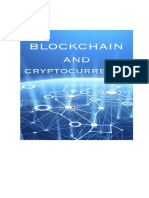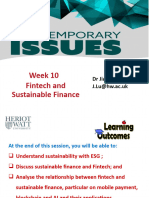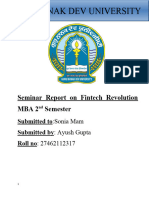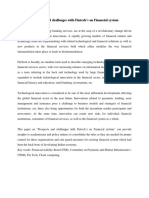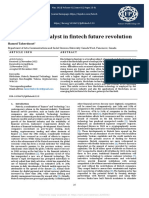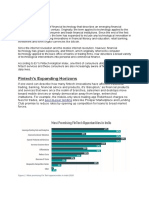Course Title: FINTECH Total Credits: 3
Course Objectives: The purpose of this course is to provide the students with a holistic view
of the Fintech ecosystem in both the Indian and global context. While most courses in this
area provide either finance or a technology perspective of the industry, we aim to bridge the
gap between the two through industry frameworks and use cases. This course will enable
participants in identifying areas where financial technologies can be utilized to create new
Fintech solutions as well as for rebuilding products & processes in Financial Institutions.
Course outcomes: After completing this course a student will have the ability to:
1. Explain and understand the integration of technology with finance
2. Comprehend the impact of technology in the delivery of financial services
3. Identify the players involved in Fintech Payments & Lending system.
4. Describe the technologies underlying Digital Banking.
5. Recognize the opportunities brought in by Fintech in the area of sustainable finance.
Course Content
Units Number of
Lectures
Unit -1 Introduction to Fintech 8
Introduction to Fintech; Financial Technology
· A Brief Background & History of Fintech, A Timeline & Journey
Map
· Rise of Fintech, Pillars, Drivers & Enablers of Fintech
· Advantages & Risks associated with Fintech
· The world of Fintech - Modern Banking Landscape
· Key players in the fintech ecosystem
Unit II: Disruptive Technology Trends: 10
· New age technologies, Overview of Disruptive Technologies
· Disruptive Innovations, Innovation Cycle - Phases, Metrics,
Components
· Value Networks & Value Propositions - Identifying the points of
disruption, Open Innovations.
· World of Services & Platforms, Introduction to As-A-Service
Banking, Banking as a Service (BaaS) , Banking as a Platform (BaaP),
Difference between BaaS & BaaP
· API Based Banking, Fintech Saas - Software as a Service (SaaS),
Human as a Service (HuaaS), Overview of Open Banking Architecture,
Growth of Banks via BaaS
· Fintech Start Up Ecosystem- Accelerators, Marathons
· Hackathons, Proof of Concept (POCs), Y-Combinators &
Unicorns.
7
Unit III: Fintech in Payments & Lending:
� · Overview of digital payment system – mobile wallets, online
payment gateways
· Peer to peer lending models, and Peer to Peer Insurance
· Crowd funding platforms and their impact on traditional financing
· Innovative products in mobile based application
· Credit cards – POS based ecosystem
· Global payment ecosystem
Unit IV: Digital Banking Architecture, Designing Principles, 12
Components of Digital Architectures
· Design Thinking, Importance of Design Thinking, Design
thinker’s mindset, Phases in Design Thinking
· Design Thinking at the Heart of Fintech Revolution, Design
Research Strategies, Ideation and Prototyping Strategies
· Overview of Architectural Transformation.
· Branchless Banking, Rise & Integration of Alternate Banking,
Embedded Finance.
Unit V: Sustainable finance and government initiatives: 8
· Introduction to sustainable finance - Green Finance – Green
Fintech - Green financial Instruments
· Role of fintech in promoting financial inclusion: social impact
· Future trends and challenges in sustainable finance through
fintech
· Government Initiatives and Regulations in India
· Role of Central Bank Digital Currencies (CBDC) in promoting
financial sustainability
· Fintech-the road ahead
References:
1. FinTech: The New DNA of Financial Services" by Pranay Gupta and T. Mandy Tham
2. "Introduction to FinTech" by Jeffrey H. M. Chiu and Douglas W. Arner
3. "Financial Technology: Case Studies in FinTech Innovation" by Giovanni Cesare and Daniel
Kind
4. "The Economics of FinTech and Digital Currencies" by Thomas P. P. Ho and S. Y. P. Chin
5. "Handbook of Digital Finance and Financial Inclusion" edited by David Lee Kuo Chuen
6. "The FINTECH Book: The Financial Technology Handbook for Investors, Entrepreneurs, and
Visionaries" by Susanne Chishti and Janos Barberis








